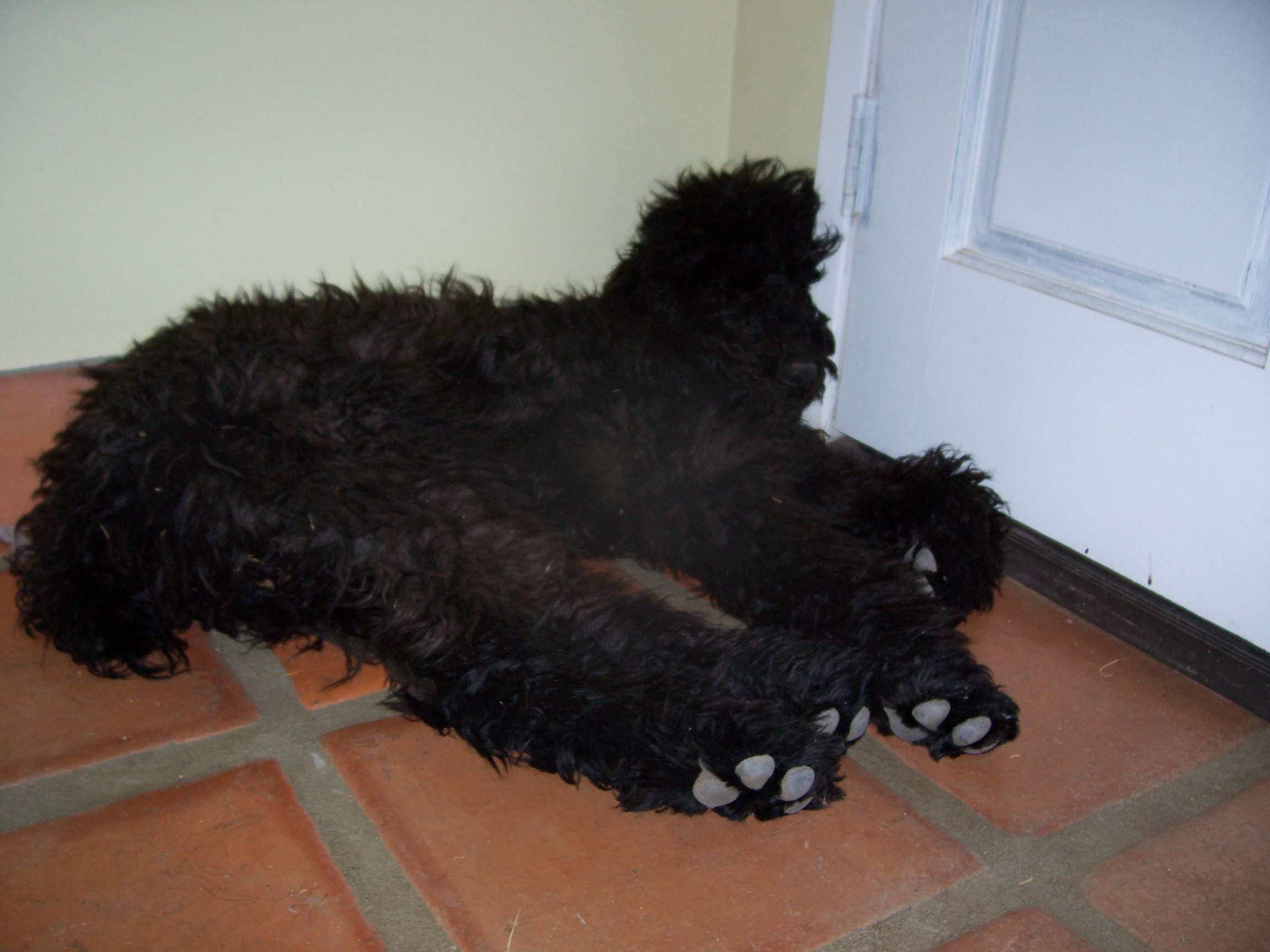Archives for Dog Psychology category
Posted on Oct 22, 2009
Behavioral Modification, Dog Psychology, Dog Training, Retractable Leashes
Retractable leashes have their place. That place is not during training. While this leash seems to be very dog-friendly, it is not necessarily human-friendly, and does not provide the control most people need during training. When your dog responds to you while on a walk, it won’t matter what type of collar or leash you choose.
If you’re intention in having your dog on a leash is to learn to listen, respond, and respect you, then don’t use retractable leashes. I have heard from more than one person who has fractured their wrist by the handle when getting pulled by their dog (more about this below).
A favorite of mine is when someone approaches with two barking dogs who are pulling on the ever-lengthening thread toward my dogs (or dogs I am training) as they yell over the noise of their dogs’ vocal expression, “they’re friendly!” My advice is to respond with, “mine aren’t!” I use it all the time in order to keep them moving along down the road as I work with the dog who was the object of their attention to sit and stay as they pass.
You can also feel free to respond, “please keep walking, we’re in training.” Most people will respect it even if their dog has no clue what the word “training” means.
There is no way of knowing if once the dogs greet and the leashes get entwined their won’t be an altercation. It takes time to have a dog realize who is in charge and to listen to respond especially when an overly-anxious, uncontrolled dog is approaching.
This post isn’t so much about the negatives of retractable leashes as it is about the people using them without any sense of understanding the dog’s perspective and who is walking who. A dog doesn’t need to be heeling all the time. They should be given that freedom to sniff and be a dog; however, you (or they) may be asking for trouble if they are allowed to have full freedom on the leash and they still pull you down the street in an anxious state.
If you use a retractable leash and want to know more about my thinking on their correct usage, please send a note. I am glad to answer your questions!
Here’s an article on retractable leashes from Consumer Reports. Not intended as a scare tactic, but as information: Retractable Leashes Pose Problems
Posted on Oct 14, 2009
Dog Humor, Dog Psychology, Dog Training, Uncategorized
Perhaps you saw the segment on Animal Planet where a teacher taught his Labrador to read. The dog would read words printed on a flash card, and amazingly enough, would follow through with the instruction on the card! This is impressive.
I have seen a lot of amazing demonstrations of a dog’s intelligence, but the following tops them
all. . .my dog, Mac, can read books! In fact, he reads until he falls asleep. I think
I heard him say, “if only I had thumbs, turning pages would be so much easier.” Now I know what he was talking about.
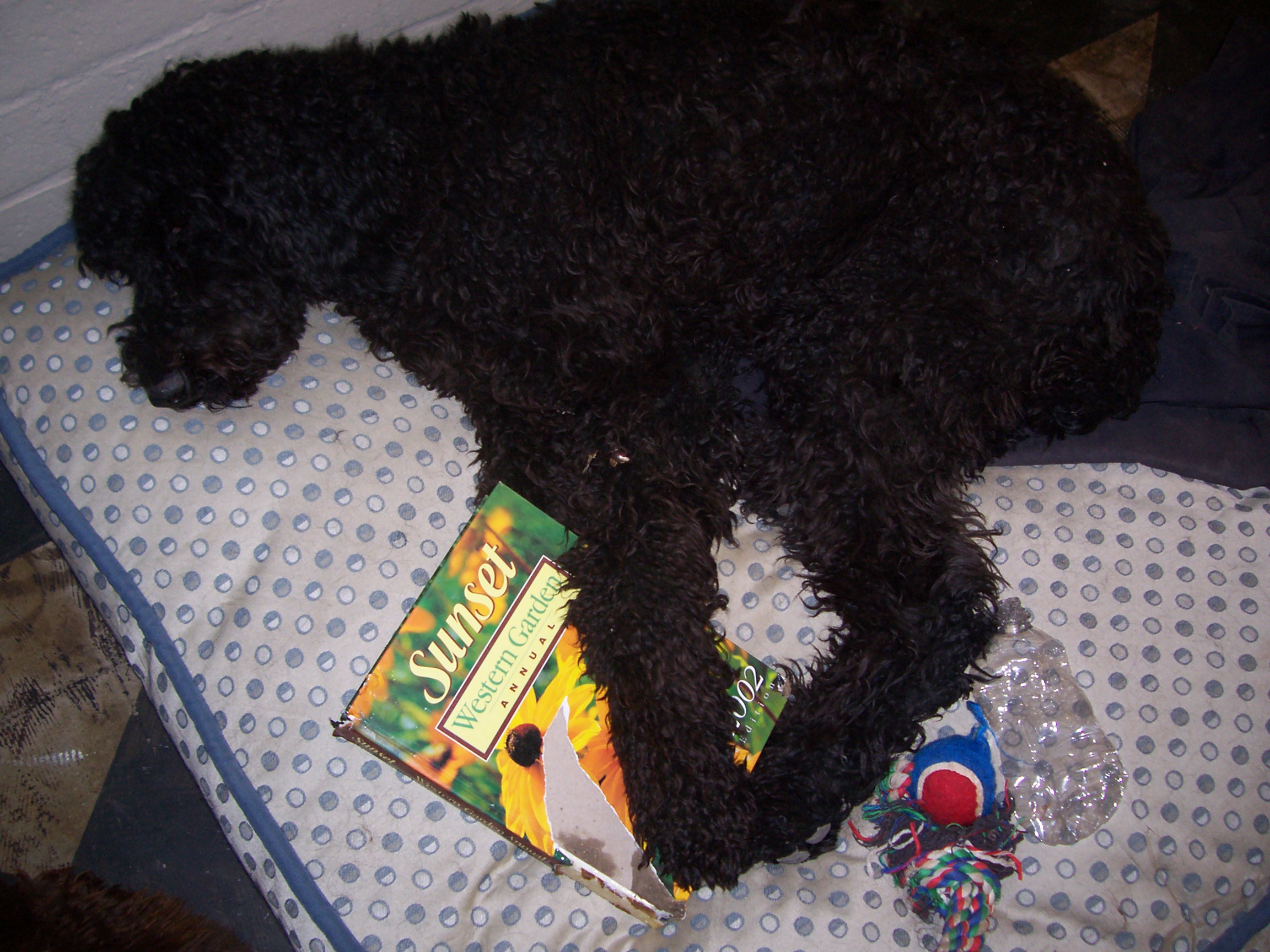
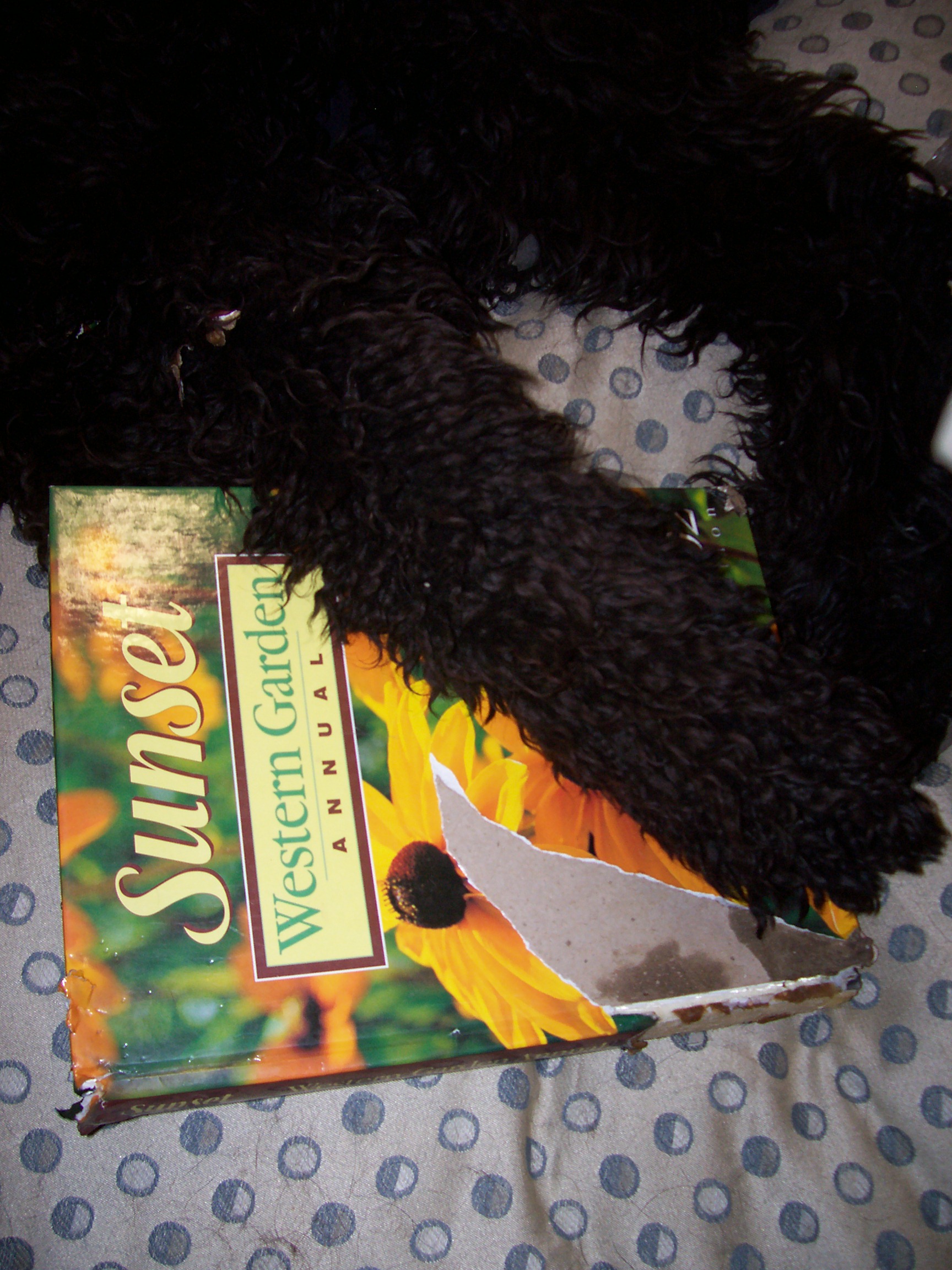
Posted on Oct 09, 2009
Behavioral Modification, Dog Psychology, Dog Training, Doggie Rehab
Some people, trainers included, believe that dogs are just dogs. They can be treated harshly and will be fine. They can be left outside all of the time without being given attention, and be fine. I guess it depends on your definition of fine.
Dogs aren’t human (duh, I know!) They can, however, be treated in ways that destroy or, at a minimum, lessen their spirit or true nature. This can happen if they are treated too much like a human, and it can and does happen if they are sensitive in nature and treated with excessive force.
I have been working with a sweet Doberman who was sent away for training. She was trained alright. She returned to her human, with her head down, ears flat, and looking as sad as a dog can look. In just a few days, she is starting to act like a dog again. More than that, she’s acting like who she is. She hasn’t forgotten her commands (greatly needed as she is a service dog), but she is beginning to lift her head and receive praise rather than waiting for the force of a heavy-handed correction.
Dogs are like us! Some are more sensitive than others, so not all techniques work the same on every dog. It’s important to consider the breed when you are training. A Golden Retriever or Lab can sit or lie down in an instant. Great Danes, Dobermans, and Greyhounds are several of the breeds that sit and lie down in what may appear to be slow motion. Harsh corrections for not responding quick enough will only serve to make them cower and work against the relationship you are hoping to establish with them.
Be open to options and varying opinions when training your dog. There is more than one way to “train” a dog and it is certainly better to choose one that let’s your dog learn and still be the dog they are intended to be!
Posted on Oct 04, 2009
Behavioral Modification, Dog Psychology, Dogs and Instinct, Pit Bull, Timid Dog Behavior
Dogs are similar to us when it comes to needing to feel secure. They may have a past of abuse or may be genetically hard wired to be timid or insecure. Everyone knows and appreciates what it means to hear someone say, “I’ve got your back.” That someone accepts you for who you are; even, or especially when you feel insecure. Olive, a very special Staffordshire Bull Terrier (with an abusive past), was openly insecure and needed someone to have her back in more ways than one.
In her case, it was more that she needed to have someone’s back – literally, to be able to relax and trust what was going on around her. If you don’t think dogs need a connection to feel secure, think again.
In this photo, Olive was finding comfort on her life-long companion, Chapin, who always allowed Olive to find her “calm” while resting on top of Chapin.
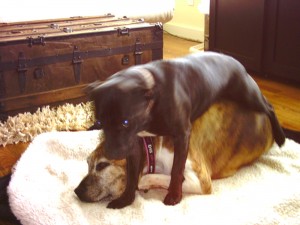
After Chapin passed, the next two photos show how Olive tried to find that same security in Zoe. It appears that Olive knew something very valuable – they had her back while she had theirs.
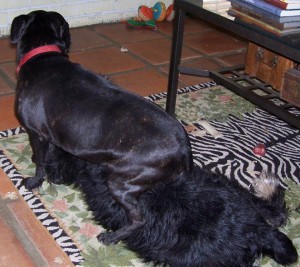

Posted on Oct 01, 2009
Behavioral Modification, Discussion Tab, Dog Psychology, Dog Training, Dogs and Instinct
As a constant observer of dogs, I am still amazed at how shifts in their behavior occur as they mature. It is interesting to see how at times they will appear to be practicing to be dominant. I’ll explain using two separate incidences.
I was working with a dog who is a big fan of chasing anything that moves or may move or used to move! On this occasion, we were making progress with him when I looked down to notice his hackles were up. I couldn’t help but think the timing was off. Something in him triggered this response and he even seemed unsure about his behavior. Natural, though it is, I believe he was in a sense trying out his maturing instincts. The dog didn’t appear to feel threatened. It was either a delayed or premature response. Practice perhaps?
Recently, my own dog who is 18 months of age, kicked up his back legs for the very first time. It was a macho move, but he was awkward and the action appeared misplaced. He looked up at me as if to say, “look, I’m kicking my legs up!” It was like he was practicing for when he would need to show his new-found dominant move. My other thought was that he had witnessed this strut as done by his little (tiny in comparison) brother, who exhibited this macho-manner after nearly every potty break.
I believe they are trying on things much like when you are fortunate enough to see a child as they catch their reflection in a mirror practicing a confident look or pose. It’s not a necessary posture at that moment, but it may be and one needs to be prepared!
As you enjoy the many changes that occur in the life of your dog, watch carefully for those times when they appear to be growing into their instincts.
If your maturing dog is exhibiting new behaviors and you aren’t sure how to handle them, please submit your question in the box to the right (I share it with Melody).
Posted on Sep 28, 2009
Aggression, Behavioral Modification, Dog Food, Dog Psychology
I have heard from numerous clients that their dog is a picky eater. They either say that or, “he doesn’t eat very much.” Typically, I suggest moistening the food with a little water and perhaps adding a few snippets of something a little more tasty than their kibble. This works for some dogs. There’s something about a little gravy that turns meal time into a treat!
I have had several of these “picky” eaters boarding with me, and guess what? When they were around other dogs eating, they paid more attention to their food bowl and making sure the other dogs did not move in on their what-used-to-appear-bland kibble.
It may not be feasible for you to have your dog eat with another dog, but I can almost guarantee, they would have a new appreciation for the food that is set before them! I don’t suggest feeding dogs out of the same bowl, but this was a photo opportunity I couldn’t pass up…
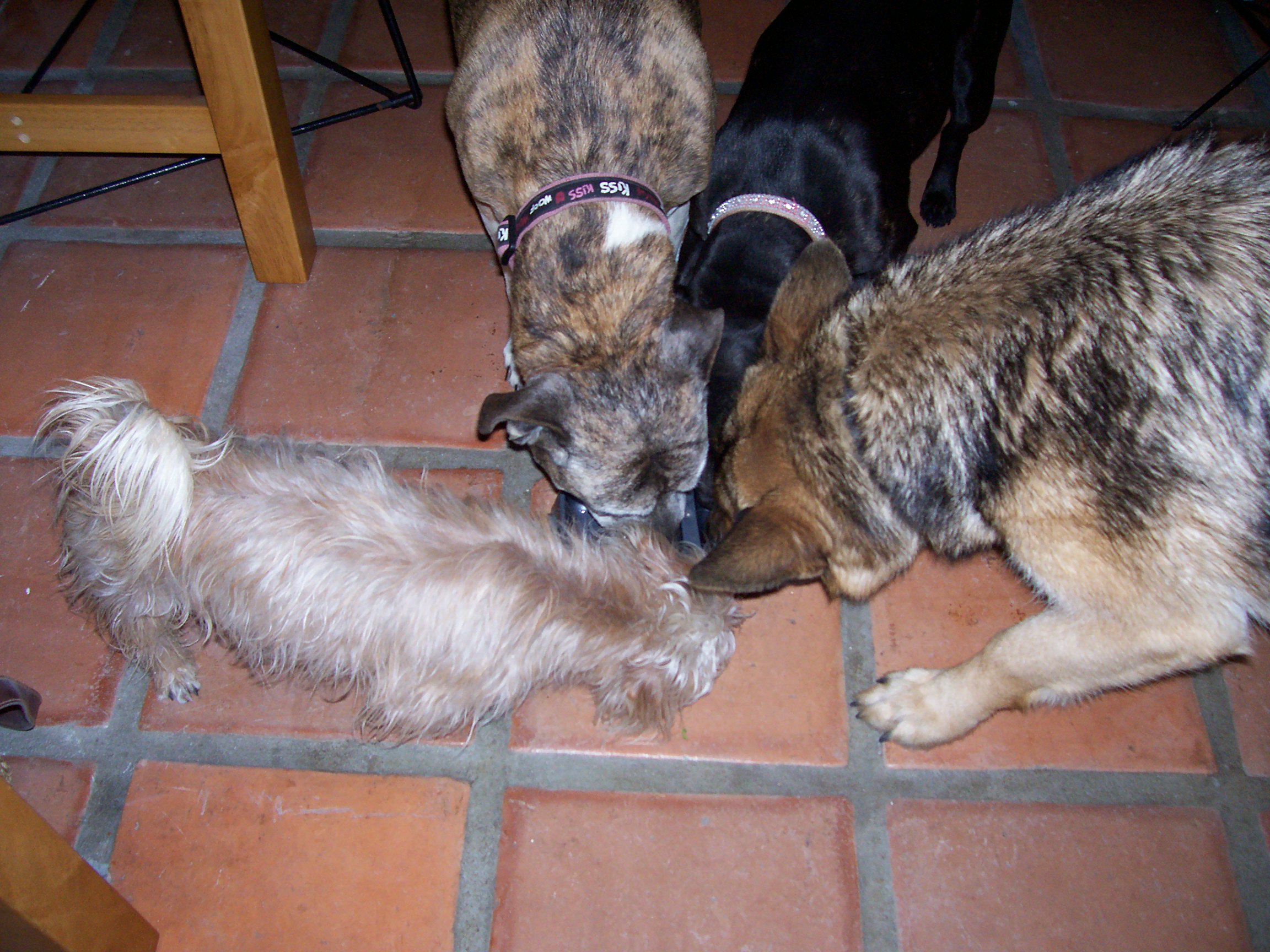
By the way – notice that two of the dogs are Pit Bulls. Somone forgot to tell them to be aggressive!
Posted on Sep 22, 2009
Behavioral Modification, Dog Chases Car, Dog Psychology, Dog Training, Palm Springs Dog Training
If your dog is one of those that loves to focus and obsess on moving objects, i.e., cars, golf carts, or even vapor trails from airplanes, this post is for you.
This activity may now be a pattern of behavior that is rapidly becoming a habit. See car – chase car. Sound familiar? You hear the engine in the distance (just after the dog) and brace yourself with the you-won’t-pull-me-down-this-time stance as you feel embarrassed and aggravated that your dog is officially a car chaser.
- First, you want to master (and be the master) of having your dog heel. This means your dog is walking on a loose leash next to your side.
- Work with them to sit when you stop and on command even when they are distracted. Add stay and increase their ability to stay by throwing treats in front of them, walking all the way around them, and using other staged distractions.
- Now, take your dog to the street and have someone in a car work with you to desensitize the dog to the moving vehicle. Have the car drive by slowly and stop in front of you allowing you time to have your dog sit. Repeat this process eventually working with your dog in a down and stay. This is a more submissive and relaxed position and they can’t lunge when lying down.
- The second you sense they are beginning to focus on the car or even just the sound of it approaching, say their name in a positive tone. You want them to shift their focus to you. You will be wasting your voice and energy if they have already bolted, you’ve lost control, and you are yelling their name followed by sit. Take a breath, get yourself focused and feeling confident, and continue the training.
If this behavior has been tolerated for awhile, it may take awhile to break their pattern of response. Some breeds are more prone to chase moving things, so you are also working against or with that instinct. Take it slow. Too much, too fast, and your dog may get over-stimulated.
It’s also important to consider that if your dog has been confined all day and has energy to burn, provide exercise prior to training so all of that energy isn’t going toward the behavior you want to correct – in this case, car chasing.
Please contact me in the box to the right if you have any questions! (I share this box with Melody)
Posted on Sep 12, 2009
Behavioral Modification, Discussion Tab, Dog Psychology
There’s an interesting study about dog behavior being conducted at Harvard. A few of the observations:
* Is your dog patient? If given a choice between 1 treat immediately, or 5 treats in a few minutes, will your dog wait patiently for the 5 treats?
* Can your dog cooperate with a human or another dog to gain access to a highly valued reward, and if this capacity is in place, does your dog recognize that some efforts to cooperate merit greater rewards than others?
* Does your dog distinguish between accidental and intentional actions?
Here’s the link and a short video worth watching. Harvard Canine Cognition Lab
Some of you may not want to know how smart your dog really is! I’m waiting for them to clean up after themselves and perhaps do a little dusting.
Posted on Sep 03, 2009
Behavioral Modification, Dog Psychology, Dog Training
Gaining the respect of someone is much the same as it is with a dog. It’s not about how strong or big or how loud you can yell. It’s about being in a calm state of mind that is confident, in control, and worthy of the respect you expect.
Melody, a 5 lb yorkie, came into the house and gained the respect of the other dogs. Let’s face it, she’s a toothless, de-barked little thing who manages to handle the big dogs just fine. She is afraid of a human’s intention, but a 120-lb Dane will easily move away from it’s bowl of food if Melody approaches. They all clear a path for her as she dodges big feet and long legs to get to her bed.
If she had words, she would be a good example for a woman’s self-defense course on how to assert yourself with little effort. She is who she is and they know she knows it! I wonder what she does know? It’s definitely the calm, assertive nature Cesar Millan speaks of so often.
Humans usually require training tools in working their dogs, and there’s nothing wrong with that. That’s what they are – tools. Be it a collar and a leash or a remote training device, it will be far more effective when we are worthy of the dog’s respect without these tools. When the collar comes off, the dog should still listen and respond and basically look to you for approval because they know who is in charge.
Their tail won’t be tucked in fear, their ears won’t be back and heads down because they are afraid of the hand approaching them. They will be happy, confident, and balanced dogs whose respect of you is natural.






